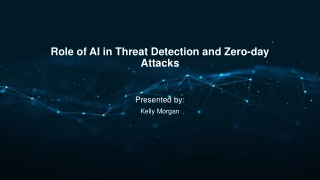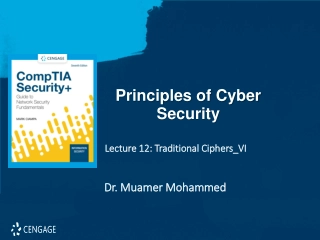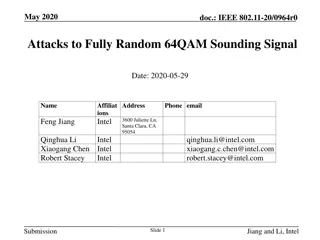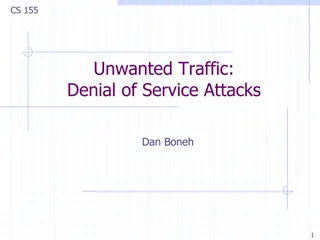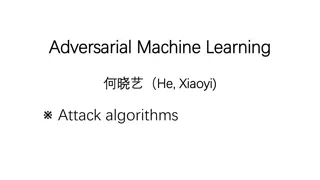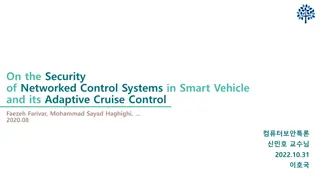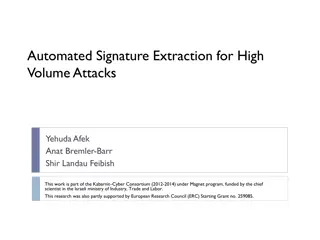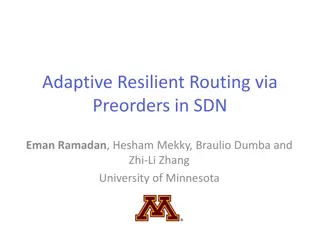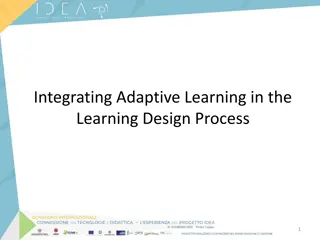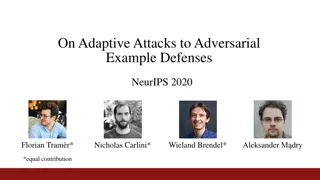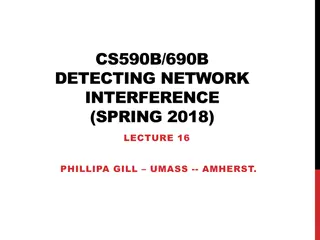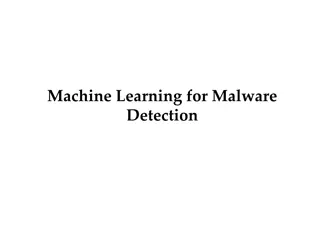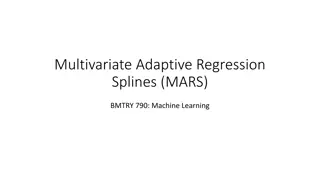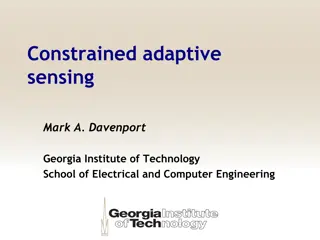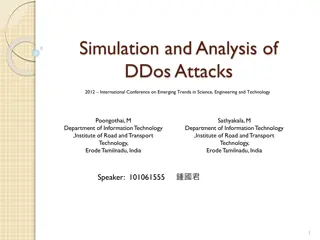Types Cyber Attacks: Cyber Security Training Workshop
Join our Cyber Security Training Workshop to learn about different types of cyber attacks such as social engineering attacks, DDoS attacks, malware attacks, MitM attacks, APTs, and password attacks. Enhance your knowledge and skills in cyber security.
15 views • 45 slides
Adversarial Machine Learning
Evasion attacks on black-box machine learning models, including query-based attacks, transfer-based attacks, and zero queries attacks. Explore various attack methods and their effectiveness against different defenses.
21 views • 60 slides
Adversarial Machine Learning in Cybersecurity: Challenges and Defenses
Adversarial Machine Learning (AML) plays a crucial role in cybersecurity as security analysts combat continually evolving attack strategies by malicious adversaries. ML models are increasingly utilized to address the complexity of cyber threats, yet they are susceptible to adversarial attacks. Inves
1 views • 46 slides
Understanding Malicious Attacks, Threats, and Vulnerabilities in IT Security
Malicious attacks, threats, and vulnerabilities in IT systems pose significant risks and damages. This chapter explores the types of attacks, tools used, security breaches, and measures to protect against cyber threats. Learn how security professionals safeguard organizations from malicious attacks
0 views • 24 slides
Role of AI in Threat Detection and Zero-day Attacks
Cybercrime has been on the rise, especially with the surge in zero-day attacks targeting various industries. State-sponsored actors, like Chinese groups, dominate zero-day exploits, challenging traditional detection methods. Incorporating AI, machine learning, and deep learning is vital in enhancing
0 views • 9 slides
Principles of Cyber Security
Threat actors prioritize targeting networks to exploit vulnerabilities, leading to various attacks such as interception, DNS attacks, and MITM attacks. MITM attacks involve eavesdropping on communications or impersonating parties, with techniques like session replay to steal credentials. Implementin
0 views • 7 slides
Localised Adaptive Spatial-Temporal Graph Neural Network
This paper introduces the Localised Adaptive Spatial-Temporal Graph Neural Network model, focusing on the importance of spatial-temporal data modeling in graph structures. The challenges of balancing spatial and temporal dependencies for accurate inference are addressed, along with the use of distri
3 views • 19 slides
Understanding Phishing Attacks: Risks, Prevention, and Awareness
Phishing attacks are prevalent cybercrimes where attackers deceive individuals into divulging sensitive information or engaging in harmful actions. These attacks can happen through various channels such as emails, texts, or websites. The perpetrators aim to manipulate emotions like curiosity, greed,
1 views • 47 slides
Managing Covid-19 Cyber and Data Protection Risks
Exploring the risks and challenges related to cyber attacks and data protection amidst the Covid-19 pandemic. The agenda covers an overview of cyber-attacks, recent developments, protections against cyber attacks, data protection concerns during lockdown, compliance steps, and employee rights issues
1 views • 35 slides
Mitigation of DMA-based Rowhammer Attacks on ARM
Practical strategies are presented in "GuardION: Practical Mitigation of DMA-based Rowhammer Attacks on ARM" to defend against Rowhammer attacks on ARM architecture. The paper discusses Rowhammer defenses, RAMPAGE attacks on Android OS, and introduces GuardION as a lightweight mitigation approach. I
0 views • 48 slides
Cybersecurity Challenges: Attacks on Web Applications and Cost of Security Breaches
In the realm of cybersecurity, attacks on web applications pose a significant threat with 78% of attacks targeting applications. The consequences of these attacks are immense, with projected costs reaching $6 trillion annually by 2021. Notable breaches in recent years highlight the urgency for robus
8 views • 23 slides
Understanding Buffer Overflow Attacks at Carnegie Mellon
Learn about the Carnegie Mellon 15-213 Recitation Attack Lab, where you can hijack programs using buffer overflow attacks. Gain insights into stack discipline, stack frames, and defeating secure programs through return-oriented programming. Dive into topics like stack smashing attacks, buffer overfl
8 views • 24 slides
Attacks on Fully Random 64QAM Sounding Signal in IEEE 802.11-20/0964r0
Presentation by Intel demonstrates vulnerabilities in fully random QPSK and 64QAM sounding signals in IEEE 802.11-20/0964r0. Proposed attack methods, including Viterbi equalizer attacks, and solutions such as Secure LTF mechanism and windowed FFT are discussed to enhance security in ranging. The pre
0 views • 31 slides
Understanding Denial-of-Service Attacks and Defense Strategies
Denial-of-Service attacks pose a serious threat where attackers flood networks with traffic, leading to system crashes and slowdowns. Explore the impact, expected results, and various categories of DoS attacks such as bandwidth attacks, protocol exceptions, and logic attacks. Learn how to defend aga
0 views • 61 slides
Understanding Network Denial of Service (DoS) Attacks
Network Denial of Service (DoS) attacks aim to disrupt services by overwhelming them with traffic. These attacks can occur at various layers of the network stack and exploit weaknesses to achieve their goal. Amplification attacks, such as the Smurf attack and DNS Amplification attack, can significan
2 views • 52 slides
Understanding Adversarial Attacks in Machine Learning
Adversarial attacks in machine learning aim to investigate the robustness and fault tolerance of models, introduced by Aleksander Madry in ICML 2018. This defensive topic contrasts with offensive adversarial examples, which seek to misclassify ML models. Techniques like Deep-Fool are recognized for
0 views • 29 slides
Preventing Active Timing Attacks in Low-Latency Anonymous Communication
This research addresses the vulnerabilities of onion routing to timing attacks and proposes solutions to prevent active timing attacks, focusing on low-latency anonymous communication systems. Various problems related to timing attacks in onion routing are analyzed, including the role of adversaries
0 views • 52 slides
Understanding Adversarial Machine Learning Attacks
Adversarial Machine Learning (AML) involves attacks on machine learning models by manipulating input data to deceive the model into making incorrect predictions. This includes creating adversarial examples, understanding attack algorithms, distance metrics, and optimization problems like L-BFGS. Var
0 views • 88 slides
Understanding Control Hijacking Attacks in Software Systems
Control hijacking attacks, such as buffer overflows and format string vulnerabilities, allow attackers to take over a target machine by manipulating application control flow. Knowledge of C functions, system calls, CPU, and OS used is crucial for executing these attacks successfully. This summary pr
1 views • 55 slides
Understanding Control Hijacking Attacks and Defenses
Control hijacking attacks pose a significant threat by allowing malicious actors to manipulate data and control flow within a system. This article explores common attack methods like stack smashing and heap spraying, along with defenses such as fixing bugs, implementing platform defenses, and markin
1 views • 36 slides
Effective Method to Protect Web Servers Against Breach Attacks
Abdusamatov Somon presents an effective method called HTB to protect web servers against breach attacks, focusing on secure computation and mitigation. The research addresses side-channel attacks based on compression and the CRIME BREACH issue, providing insights into implementing the breach attack
1 views • 13 slides
Strategies to Protect School Systems from Cyber Attacks
Schools are increasingly becoming targets of cyber attacks, making cybersecurity measures crucial. The article discusses the importance of responding to cyber attacks, creating incident response plans, and being vigilant against interception attacks. It outlines the steps to detect, document, and mi
0 views • 21 slides
Security Analysis of Networked Control Systems in Smart Vehicles
This paper explores the security challenges faced by networked control systems in smart vehicles, focusing on adaptive cruise control technology. It discusses the vulnerabilities in cyber-physical systems, such as intrusion detection systems, and highlights the potential risks posed by cyber attacks
0 views • 21 slides
Automated Signature Extraction for High Volume Attacks in Cybersecurity
This research delves into automated signature extraction for high-volume attacks in cybersecurity, specifically focusing on defending against Distributed Denial of Service (DDoS) attacks. The study discusses the challenges posed by sophisticated attackers using botnets and zero-day attacks, emphasiz
0 views • 37 slides
Optical Fiber Calibration System & Adaptive Power Supply by J. Cvach
Introduction to an optical fiber calibration system and adaptive power supply developed by J. Cvach from the Institute of Physics, ASCR, Prague. The system includes an LED driver, notched fibers, and adaptive power supply for various applications, such as the calibration of the CALICE AHCAL and LHCb
0 views • 13 slides
Adaptive Resilient Routing via Preorders in SDN
This research paper discusses the challenges of path-based routing in modern networks and introduces a novel approach called Adaptive Resilient Routing via Preorders in Software-Defined Networking (SDN). The authors emphasize the limitations of traditional routing schemes, the importance of resilien
0 views • 42 slides
Enhancing Learning Design with Adaptive Learning Solutions
Explore the integration of adaptive learning in educational design processes to address common challenges such as high drop-out rates and student disengagement. Discover key players in learning design and the benefits of intelligent adaptive learning systems in catering to individual student needs e
0 views • 56 slides
Understanding Horticulture and Agriculture: Adaptive Strategies in Human History
This article delves into the development of adaptive mechanisms in human history, focusing on horticulture and agriculture as key strategies. It explains the differences between horticulture and agriculture, explores the concept of cultivation continuum, and discusses pastoralism as an adaptive stra
0 views • 13 slides
Targeted Deanonymization via the Cache Side Channel: Attacks and Defenses
This presentation by Abdusamatov Somon explores targeted deanonymization through cache side-channel attacks, focusing on leaky resource attacks and cache-based side-channel attacks. It discusses the motivation behind these attacks, methods employed, potential defenses, and the evaluation of such att
0 views • 16 slides
Evaluating Adaptive Attacks on Adversarial Example Defenses
This content discusses the challenges in properly evaluating defenses against adversarial examples, highlighting the importance of adaptive evaluation methods. While consensus on strong evaluation standards is noted, many defenses are still found to be vulnerable. The work presents 13 case studies o
0 views • 9 slides
Understanding Network Security Vulnerabilities and Attacks
Explore the world of network security vulnerabilities and attacks, including Denial-of-Service (DoS) and Distributed-Denial-of-Service (D-DoS), security flaws in the TCP/IP protocol suite, ICMP attacks, routing attacks, and TCP attacks. Learn about common security vulnerabilities such as address spo
0 views • 36 slides
Understanding Network Interference in CS590B/690B Lecture
Delve into the realm of network interference through the CS590B/690B lecture with Phillipa Gill at UMass Amherst. Explore topics such as Internet routing, timing attacks, BGP hijacks, Tor network functionality, relay selection, collusion scenarios, use of guards, web site fingerprinting attacks, tra
0 views • 11 slides
Machine Learning for Cybersecurity Challenges: Addressing Adversarial Attacks and Interpretable Models
In the realm of cybersecurity, the perpetual battle between security analysts and adversaries intensifies with the increasing complexity of cyber attacks. Machine learning (ML) is increasingly utilized to combat these challenges, but vulnerable to adversarial attacks. Investigating defenses against
0 views • 41 slides
Robustness of Linear Sketches to Adaptive Inputs in Big Data Processing
Exploring the robustness of linear sketches in handling adaptive inputs in big data scenarios. The study covers applications like compressed sensing, data streams, and distributed computation. It delves into the challenges posed by adaptive inputs and the implications for correctness and efficiency
0 views • 27 slides
Explore Adaptive Recreation and Sports for Individuals with Disabilities
Discover adaptive recreation opportunities for individuals with disabilities, including winter and summer activities such as skiing, biking, kayaking, and rock climbing. Learn about the mission of providing inclusive leisure options and find volunteer opportunities with organizations like High Count
0 views • 8 slides
Enhancing Climate Change Adaptive Capacity Through ICTs
Developing adaptive capacity to address climate change in vulnerable communities is crucial. Integrating expert and local knowledge using Information and Communication Technologies (ICTs) can help, but challenges like digital exclusion must be overcome. Understanding climate change as a complex prob
0 views • 12 slides
Multivariate Adaptive Regression Splines (MARS) in Machine Learning
Multivariate Adaptive Regression Splines (MARS) offer a flexible approach in machine learning by combining features of linear regression, non-linear regression, and basis expansions. Unlike traditional models, MARS makes no assumptions about the underlying functional relationship, leading to improve
0 views • 42 slides
Constrained Adaptive Sensing and Benefits of Adaptivity
Constrained adaptive sensing involves estimating sparse signals with constraints, utilizing strategies like nonadaptive sensing and adaptive sensing. Benefits of adaptivity include reducing errors and improving estimation accuracy in signal processing. It explores the potential for improvement in re
0 views • 17 slides
Understanding DDoS Attacks: Simulation, Analysis & Defense
Delve into the world of Distributed Denial of Service (DDoS) attacks with this comprehensive study covering the architecture, advantages, bot installation phases, attack methods, defenses, and simulation. Learn about the detrimental impact of DDoS attacks on servers, their multi-tiered structure, an
0 views • 20 slides
Overview of DoS and DDoS Attacks in Cybersecurity
This content provides an in-depth overview of Denial of Service (DoS) and Distributed Denial of Service (DDoS) attacks in cybersecurity. It covers the types of attacks, including volumetric, reflected, and stealthy, along with detailed explanations and examples. Additionally, it discusses how DoS at
0 views • 8 slides




